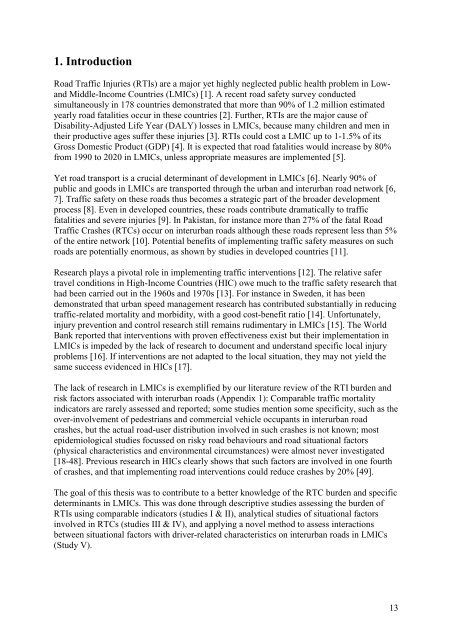thèse doctorat de l'université bordeaux 2 - ISPED-Enseignement à ...
thèse doctorat de l'université bordeaux 2 - ISPED-Enseignement à ...
thèse doctorat de l'université bordeaux 2 - ISPED-Enseignement à ...
Create successful ePaper yourself
Turn your PDF publications into a flip-book with our unique Google optimized e-Paper software.
1. IntroductionRoad Traffic Injuries (RTIs) are a major yet highly neglected public health problem in LowandMiddle-Income Countries (LMICs) [1]. A recent road safety survey conductedsimultaneously in 178 countries <strong>de</strong>monstrated that more than 90% of 1.2 million estimatedyearly road fatalities occur in these countries [2]. Further, RTIs are the major cause ofDisability-Adjusted Life Year (DALY) losses in LMICs, because many children and men intheir productive ages suffer these injuries [3]. RTIs could cost a LMIC up to 1-1.5% of itsGross Domestic Product (GDP) [4]. It is expected that road fatalities would increase by 80%from 1990 to 2020 in LMICs, unless appropriate measures are implemented [5].Yet road transport is a crucial <strong>de</strong>terminant of <strong>de</strong>velopment in LMICs [6]. Nearly 90% ofpublic and goods in LMICs are transported through the urban and interurban road network [6,7]. Traffic safety on these roads thus becomes a strategic part of the broa<strong>de</strong>r <strong>de</strong>velopmentprocess [8]. Even in <strong>de</strong>veloped countries, these roads contribute dramatically to trafficfatalities and severe injuries [9]. In Pakistan, for instance more than 27% of the fatal RoadTraffic Crashes (RTCs) occur on interurban roads although these roads represent less than 5%of the entire network [10]. Potential benefits of implementing traffic safety measures on suchroads are potentially enormous, as shown by studies in <strong>de</strong>veloped countries [11].Research plays a pivotal role in implementing traffic interventions [12]. The relative safertravel conditions in High-Income Countries (HIC) owe much to the traffic safety research thathad been carried out in the 1960s and 1970s [13]. For instance in Swe<strong>de</strong>n, it has been<strong>de</strong>monstrated that urban speed management research has contributed substantially in reducingtraffic-related mortality and morbidity, with a good cost-benefit ratio [14]. Unfortunately,injury prevention and control research still remains rudimentary in LMICs [15]. The WorldBank reported that interventions with proven effectiveness exist but their implementation inLMICs is impe<strong>de</strong>d by the lack of research to document and un<strong>de</strong>rstand specific local injuryproblems [16]. If interventions are not adapted to the local situation, they may not yield thesame success evi<strong>de</strong>nced in HICs [17].The lack of research in LMICs is exemplified by our literature review of the RTI bur<strong>de</strong>n andrisk factors associated with interurban roads (Appendix 1): Comparable traffic mortalityindicators are rarely assessed and reported; some studies mention some specificity, such as theover-involvement of pe<strong>de</strong>strians and commercial vehicle occupants in interurban roadcrashes, but the actual road-user distribution involved in such crashes is not known; mostepi<strong>de</strong>miological studies focussed on risky road behaviours and road situational factors(physical characteristics and environmental circumstances) were almost never investigated[18-48]. Previous research in HICs clearly shows that such factors are involved in one fourthof crashes, and that implementing road interventions could reduce crashes by 20% [49].The goal of this thesis was to contribute to a better knowledge of the RTC bur<strong>de</strong>n and specific<strong>de</strong>terminants in LMICs. This was done through <strong>de</strong>scriptive studies assessing the bur<strong>de</strong>n ofRTIs using comparable indicators (studies I & II), analytical studies of situational factorsinvolved in RTCs (studies III & IV), and applying a novel method to assess interactionsbetween situational factors with driver-related characteristics on interurban roads in LMICs(Study V).13
















